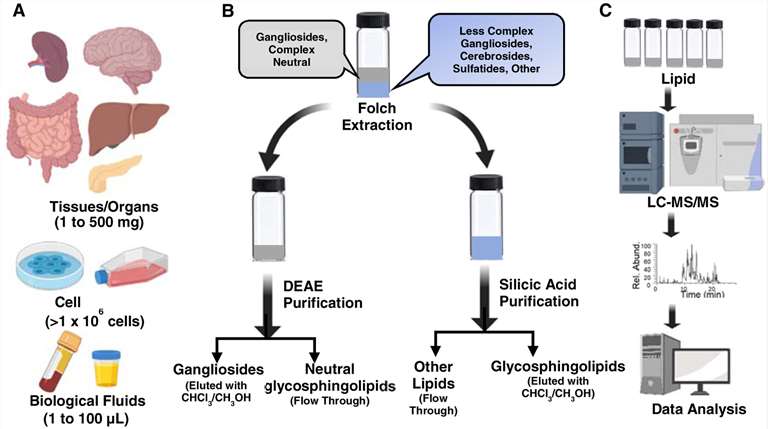Glycosphingolipid Analysis Service
- Home
- Applications
- Proteomics Analysis Services
- Glycoproteomics Analysis Services
- Glycosphingolipid Analysis Service
Service Details
Glycosphingolipids are amphiphilic composed of a ceramide backbone (hydrophobic) and a glycan head (hydrophilic), and are ubiquitous glycoconjugates on cell membranes. They play important roles in many biological processes, such as cell adhesion, embryonic development, signal transduction and carcinogenesis. It is well known that the abnormal expression of glycosphingolipids is associated with numerous diseases and can be used as a potential therapeutic target of disease biomarkers. Therefore, the analysis and characterization of glycosphingolipids is of great value in science.
Mass spectrometry has become a powerful tool, it has become the preferred method for characterizing a large number of GSLs, especially when combined with high-performance liquid chromatography. Which helps in the structural analysis and quantification of glycosphingolipids, and can completely analyze glycosphingolipids while providing sequence of glycans and composition of lipid moieties.
 Fig. 1. General
workflow to extract and isolate glycosphingolipids. (Barrientos RC, et al., 2020)
Fig. 1. General
workflow to extract and isolate glycosphingolipids. (Barrientos RC, et al., 2020)
Mass spectrometry has become an important tool for structural characterization and quantitative analysis of glycosphingolipids. With first-class mass spectrometry experience, Creative Proteomics has successfully established an advanced glycosphingolipid analysis platform. We look forward to becoming your right-hand assistant in glycosphingolipid research .
Glycosphingolipids are low in content and ionize inefficiently compared to other lipids, especially heavily glycosylated ones. Therefore, our scientists usually use a permethylation strategy for labeling during analysis to enhance the volatility and sensitivity of the analyte. Corresponding quantitative analysis was then carried out by ESI-MS or MALDI-MS.
At Creative Proteomics, our scientists develop a complete workflow for the analysis of glycosphingolipids. You only need to tell us the purpose of your experiment and send your samples to us, we will take care of all the follow-up matters of the project.
*Note, Creative Proteomics also provide MS/MS method for structural analysis of glycosphingolipids, based on the predictability of cleavage pathways, to identify known and unknown glycosphingolipids by matching experimental MS/MS spectra with database.
The ICH Q6B guideline requires comprehensive characterization of glycoprotein glycosylation. With years of experience and an experienced scientific team, Creative Proteomics provides diverse and systematic glycosphingolipid analysis service. Additionally, we can provide fully custom project designs to meet any specific requirements. If you are interested, please contact us or send us an inquiry directly.
References
For research use only, not intended for any clinical use.